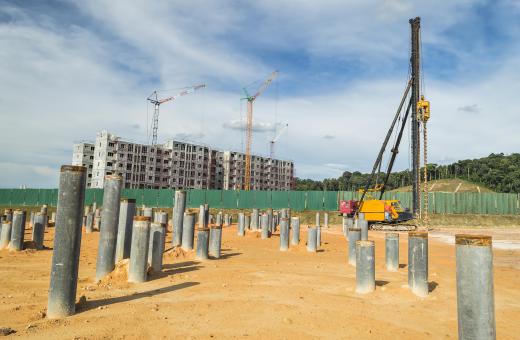Pile foundations use piles — long members of wood, steel, or concrete that can be driven into the ground — as substructures to support structures built on top of them. These foundations are often used in marine construction for bridges, piers, docks, oil rigs, and wind farms. They are also commonly used where poor soils will not support other foundation designs, and for supporting loads that would be too heavy for other types of traditional construction.
Historically, the members used in pile foundations prior to 1800 were wood. Wood piles have been in use for all of recorded history. After 1800, steel piles were developed, and in the 1900s, concrete became available. Each of these materials has advantages and disadvantages, and all of them are still used in this kind of construction.

Often, pile foundations are driven into place by a pile driver, a piece of heavy equipment that raises a weight to a certain height and drops it forcefully onto the top of the pile. The weight forces the pile into the ground. This is repeated until the desired depth is reached. Steel is particularly easy to drive into the ground in this manner. Driven concrete piles have to be specially reinforced to withstand being hammered with the weight.

Piles can also be drilled and poured in place to create this kind of foundation. This is often done in areas where pile driving may not be practical, such as where there is low headroom. Drilling also allows for pile foundations to be used in areas where soil is very dense or hard. Often, drilled piles are formed by using permanent casings, which can then be filled with concrete.
Once all of the members are put into place for a pile foundation, a pile cap is then usually placed over them. This usually takes the form of a large thickness of concrete, into which the tops of the piles are embedded. The cap acts to transfer the weight of the construction above it to the members below, which generally support the structure by absorbing its load, and transfers this to the deep subsurface upon which they rest, as well as the soil surrounding the pile.
Sometimes, grade beams are connected directly to the tops of piles. In these pile foundations, the load of the structure is transferred through the grade beam to the piles. This type of foundation is often seen in pier construction.
